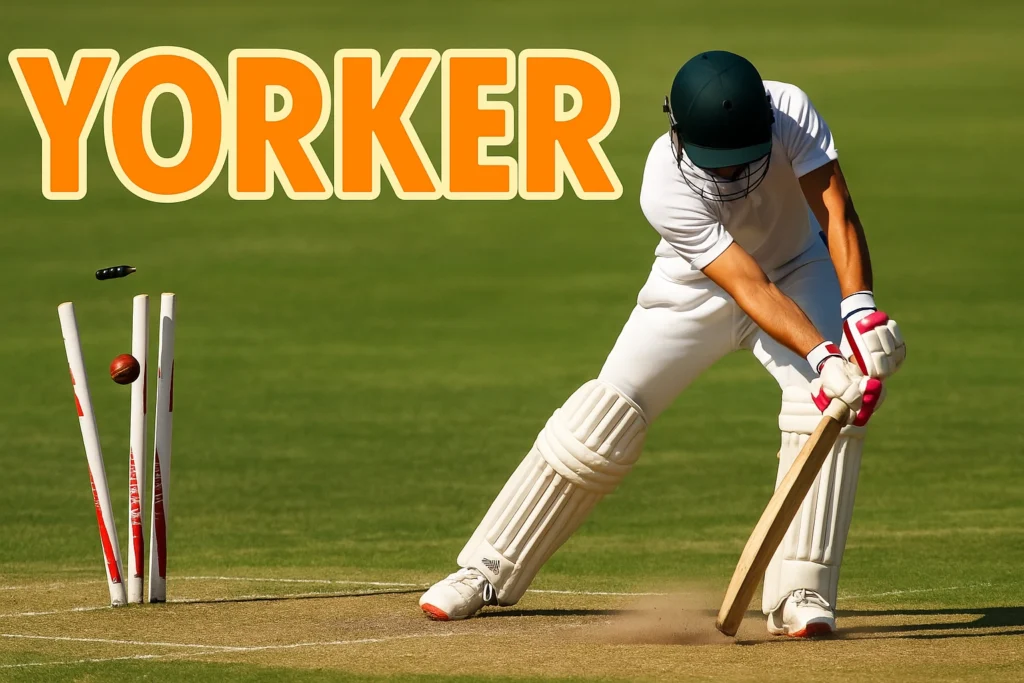Cricket is a game of skill, strategy, and timing. Among the many types of deliveries bowled by fast bowlers, the Yorker ball in cricket is one of the most powerful and challenging to execute. It’s a delivery that can turn matches, break crucial partnerships, and make even the best batsmen struggle.
In this article, you’ll learn:
- What exactly is a yorker ball
- Why it’s important in cricket
- How to bowl a yorker ball in cricket
- Common examples and tips for beginners
- The difference between a yorker ball and other deliveries
Let’s dive in.
What Is a Yorker Ball in Cricket?
A yorker ball in cricket is a type of delivery that pitches right at or near the batsman’s feet, usually at the base of the stumps. It’s so accurate and fast that it gives the batsman very little time to react.
In most cases, yorkers are aimed at:
- The crease line (where the batsman stands)
- The base of the leg or off stump
- The toe of the batsman’s front foot
When executed perfectly, the yorker is a nightmare to face, especially in death overs of a T20 or ODI match.
Read also How to Play Cricket – Full Guide for Beginners
Yorker Ball Meaning in Cricket
The term “yorker” has been around since the 18th century. Originally, it meant to trick or deceive. In modern cricket, a yorker delivery tricks the batsman because it’s hard to judge its length until it’s too late.
Why Is the Yorker So Effective?
- Hard to hit: Because it lands at the batsman’s feet, it’s hard to lift the ball for boundaries.
- Wicket-taking: A well-placed yorker can result in clean bowled or LBW.
- Pressure builder: Consistent yorkers increase dot balls and pressure in the final overs.
- Great for death overs: When batsmen are going for big shots, yorkers limit scoring opportunities.
How to Bowl a Yorker Ball in Cricket
Learning how to bowl a yorker ball in cricket takes time, but here are the core steps for beginners:
- Grip: Use your usual fast bowling grip. Some prefer a reverse grip or holding the seam tight.
- Focus on the target: Imagine a coin or shoe placed at the base of the batsman’s stumps. That’s your target.
- Release point: Release the ball slightly earlier than for a good-length delivery.
- Wrist Position: Keep your wrist firm and straight to maintain accuracy.
- Follow-through: A strong follow-through helps in control and power.
Pro tip: Practice by aiming at a shoe or marker on the pitch during net sessions.
Best Yorker Bowlers in Cricket History
Over the years, many legendary bowlers have mastered the yorker. Here are some of the most famous:
- Lasith Malinga (Sri Lanka): Known as the “King of Yorkers.” His low-arm sling action made his yorkers deadly.
- Waqar Younis (Pakistan): A master of reverse swing yorkers in the 1990s.
- Jasprit Bumrah (India): One of the best modern-day fast bowlers, especially effective in the death overs.
- Mitchell Starc (Australia): Known for fast, in-swinging yorkers that crash into stumps.
- T Natarajan (India): Gained fame in IPL for consistent yorkers under pressure.
Yorker Ball vs Full Toss: What’s the Difference?
Many beginners confuse yorker balls with full tosses, but they are very different.
| Feature | Yorker Ball | Full Toss |
|---|---|---|
| Lands at | Base of the stumps or feet | No bounce; reaches batsman in the air |
| Goal | To bowl the batsman or block scoring | Often accidental, but sometimes used for surprise |
| Effective? | Very, especially in death overs | Risky; can be hit for six |
So, while both are full-length deliveries, a full toss is rarely intentional, while a yorker is a well-planned weapon.
Example of a Yorker Ball in Action
Let’s take an example from a real match:
During the 2019 World Cup, Jasprit Bumrah bowled a perfect yorker to dismiss Shaun Marsh of Australia. The ball landed exactly at the base of off-stump, and Marsh couldn’t bring his bat down in time. Bowled!
Similarly, Lasith Malinga’s four wickets in four balls against South Africa during the 2007 World Cup were all yorkers — proving how deadly they can be.
Tips for Bowling Yorkers as a Beginner
- Practice with a target: Use a coin, shoe, or marker at the crease.
- Train under pressure: Simulate match scenarios with fielders and batsmen.
- Work on control: Bowling a fast yorker is good, but a controlled yorker is deadly.
- Mix with slower balls: A yorker followed by a slower ball keeps batsmen guessing.
- Watch legends: Study videos of Bumrah, Malinga, and Waqar Younis for technique.
Coaching Tip for Young Bowlers
Don’t try to bowl yorkers in every ball as a beginner. Start slow, build confidence in the nets, and once you’re able to land 6 out of 10 yorkers in the right area — only then bring it into match situations.
Why Yorkers Are Hard to Master
- Small margin of error: If the ball lands slightly early, it becomes a low full toss (easy to hit).
- If it lands slightly late, it becomes a half volley, which batsmen love.
- Timing, practice, and muscle memory are key.
That’s why bowlers like Bumrah and Starc are so valuable—they can deliver accurate yorkers under pressure consistently.
Final Thoughts
The yorker ball in cricket is one of the most effective deliveries when bowled correctly. It’s a powerful tool in a bowler’s arsenal, especially in T20 and ODI formats. If you’re a beginner, don’t worry if you don’t get it right immediately — with practice, you’ll improve.
So next time you’re watching a match and a batsman gets clean bowled with the ball hitting the base of the stumps — you know what it is: a perfect yorker!
Key Takeaways
- A yorker is aimed at the batsman’s feet or stumps.
- It’s used to limit runs and take wickets, especially in the final overs.
- Many cricket legends are famous for their yorkers.
- Beginners can learn yorkers with simple drills and practice.


